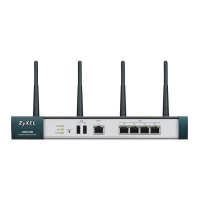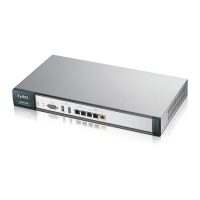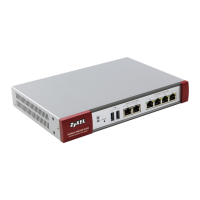Chapter 11 Route
UAG CLI Reference Guide
101
exit Leaves the sub-command mode.
[no] interface interface_name Sets the interface on which the incoming packets are received. The no
command resets the incoming interface to the default (
any). any
means all interfaces.
[no] next-hop {auto|gateway address
object |interface interface_name
|trunk trunk_name|tunnel tunnel_name}
Sets the next-hop to which the matched packets are routed. The no
command resets next-hop settings to the default (
auto).
[no] schedule schedule_object Sets the schedule. The
no command removes the schedule setting to
the default (
none). none means any time.
[no] service {service_name|any} Sets the IP protocol. The no command resets service settings to the
default (
any). any means all services.
[no] snat {outgoing-interface|pool
{address_object}}
Sets the source IP address of the matched packets that use SNAT. The
no command removes source NAT settings from the rule.
[no] source {address_object|any} Sets the source IP address that the matched packets must have. The
no command resets the source IP address to the default (any). any
means all IP addresses.
[no] sslvpn tunnel_name Sets the incoming interface to an SSL VPN tunnel. The
no command
removes the SSL VPN tunnel through which the incoming packets are
received.
[no] trigger <1..8> incoming
service_name trigger service_name
Sets a port triggering rule. The
no command removes port trigger
settings from the rule.
trigger append incoming service_name
trigger service_name
Adds a new port triggering rule to the end of the list.
trigger delete <1..8> Removes a port triggering rule.
trigger insert <1..8> incoming
service_name trigger service_name
Adds a new port triggering rule before the specified number.
trigger move <1..8> to <1..8> Moves a port triggering rule to the number that you specified.
[no] tunnel tunnel_name Sets the incoming interface to an IPSec VPN tunnel. The
no command
removes the IPSec VPN tunnel through which the incoming packets are
received.
[no] user user_name Sets the user name. The no command resets the user name to the
default (any). any means all users.
[no] policy controll-ipsec-dynamic-rules
activate
Enables the UAG to use policy routes to manually specify the
destination addresses of dynamic IPSec rules. You must manually
create these policy routes. The UAG automatically obtains source and
destination addresses for dynamic IPSec rules that do not match any
of the policy routes.
The no command has the UAG automatically obtain source and
destination addresses for all dynamic IPSec rules.
policy default-route Enters the policy-route sub-command mode to set a route with the
name “default-route”.
policy delete policy_number Removes a routing policy.
policy flush Clears the policy routing table.
policy list table Displays all policy route settings.
policy move policy_number to policy_number Moves a routing policy to the number that you specified.
[no] policy override-direct-route activate Has the UAG forward packets that match a policy route according to
the policy route instead of sending the packets to a directly connected
network. Use the no command to disable it.
Table 47 Command Summary: Policy Route (continued)
COMMAND DESCRIPTION

